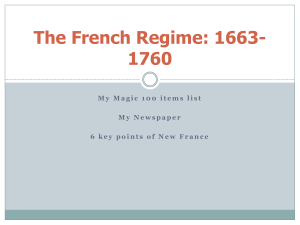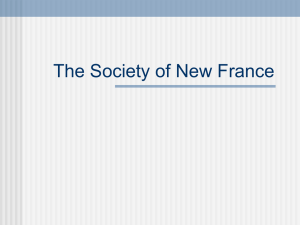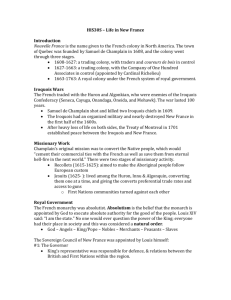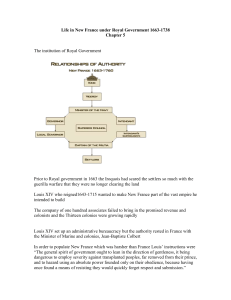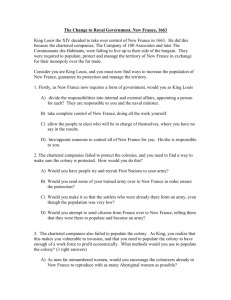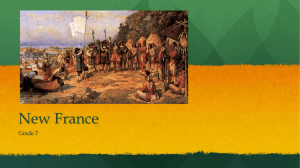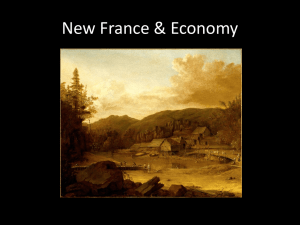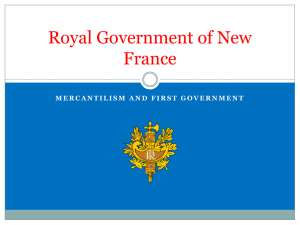2.9B Jean Talon The Empire Strikes Back
advertisement
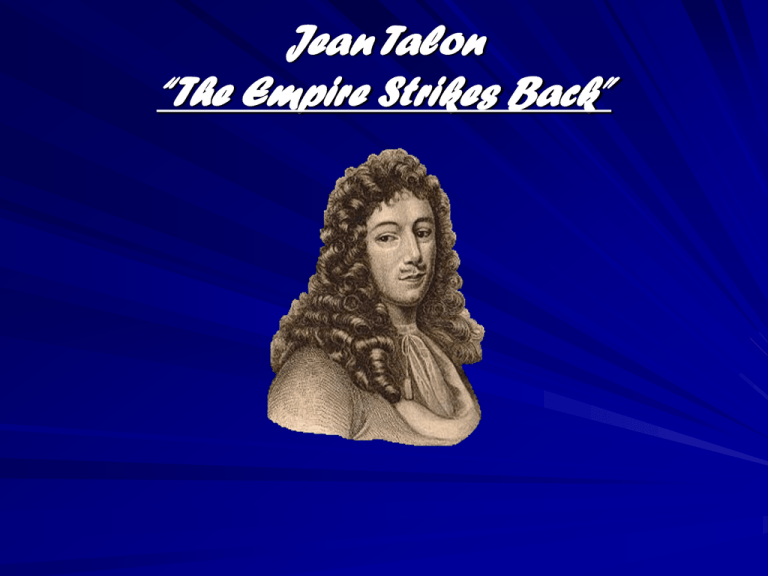
Jean Talon “The Empire Strikes Back” The “Sun King”Has Spoken… Louis XIV is the absolute monarch in N.F as of 1663. 1665 –Iroquois Nations attack French posts. - 1100 French soldiers (Carignan-Salieres Regiment) sent to end Iroquois threat. Jean Talon intendant of New France (1665-1672). Jean Talon’s mandate was to populate the Colony (doubled pop from 3,215 in 1666 to more than 7,000 in 1672). Louis XIV Reasons For Low Population Far from France Difficult ocean crossing Cold climate Fur trade did not require many European laborers and companies did not fully encourage immigration Jean Talon ‘s Immigration Policies Engages (hired workers) – Passage was paid for / came for 36 months. Soldiers – land offered to members of the CarignanSalieres Regiment / 400 remained. Filles Du Roi – young orphan girls brought over due to shortage of women / 750-1000 came. Filles Du Roi Talon and settlers Talon ‘s Incentives: “Babies Wanted!” Encouraged to marry young (payments given to young couples). Fathers fined if daughters not married by age 17 / men fined if not married by age 21 (not permitted to take part in fur trade). Family allowances provided for large Talon’s Results Natural Increase (number of births minus number of deaths). Between 1663-1760, New France’s population increased from 3,000 to 70,000 due mainly to natural increase (high birth rate). Young couples having many babies. * By 1760, 13 Colonies (English) along N.A. Atlantic Coast had over 1,500,000 people as a result of both immigration and high natural increase / birth rate. ECONOMIC DIVERSIFICATION IN THE 17TH & 18TH CENTURIES Lower Quebec City - Market Do Not Forget… New France began as a commercial colony controlled by Fur Trading Companies who had a monopoly over the fur trade and who also governed the French colony. This changed in 1660, when New France became a “royal province” under Louis XIV of France. The French Crown now controlled the colony through a governor, intendant, and bishop. Intendants, Jean Talon (1665-68 & 1670-72) and Gilles Hocquart (1731-1748), attempted to broaden the economy to have a colony based on settlements, agriculture, and industries. Intendant Jean Talon (1665-68 & 1670-72) Improved Farming: - Granted more seigneuries and encouraged immigration. - Brought horses, sheep, and cattle from France. - Commercial Crops – flax for linen; hemp for ropes; barley and hops for beer. Attempted To Create Industries: - Used forest land for timber in shipbuilding and barrel making. - Hat making from fur pelts (textile). - Tannery making leather for shoes (textile). - Pitch and tar production used in ship building. - Brewing company. Intendant Jean Talon (1665-68 & 1670-72) Encouraged Trade Introduced TRIANGULAR TRADE. 1. The colony of New France would ship furs, timber, wheat, and fish. 2. Caribbean colonies (e.g. Martinique) would supply rum, molasses, sugar, tabacco and coffee. 3. France, in turn, would supply textiles, and manufactured (finished) goods. Talon’s Industries Failed due to: Local markets (in New France) not large enough to support industries. Labour and transportation costs made “canadien” products uncompetitive on French market. Textile industries failed because N.F. population preferred wool from France. Brewing company failed because people preferred wine and brandy from France. Negative Influences Holding Back Economic Activity in New France France’s belief in mercantilism (did not want colony to produce finished goods – competed for same market. Lack of skilled workers (artisans preferred to stay in France). No capital (lack of money to invest in projects). Difficulty finding global markets and exporting goods except for furs. Bottom Line New France never attained a strong and prosperous economy, and had difficulty truly being self-supporting. The colony depended on finished goods and financial support from France.
